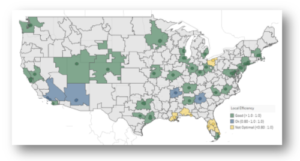
How to Stop Selling to People Who Will Never Buy Your Brand
Marketers rightly expend considerable intellectual energy devising ways to sell more to their best prospects. But one key lever is often overlooked: smartly allocating budgets between national and local media. How you determine this split can make the difference between focusing on consumers who will buy from you, and wasting money on those who never will.
The “breakeven” myth
Most of us were taught to look at local media based on a “breakeven” analysis—the point at which the costs of local media make it more efficient to buy nationally. The idea was that after that point, you essentially get the rest of the country for “free.” The breakeven point was often at only 10-15 DMAs, depending on the markets, rendering local media “inefficient” for many marketers. And we all accepted this thinking for decades. Unless you were a regional brand or had specific reasons to advertise locally (e.g., price differences by geography, limited “heavy up tests”), most nationally distributed brands ran primarily national media.
That makes some logical sense, but there are two key problems with this approach:
Lack of geographic customization.
First, the DMA is way too big of an area for many marketers, especially retailers. With the amount of data and technology we now have at our disposal, as well as the significant differences in demographics, economics, and shopping behavior geography by geography, effective media planning needs to be at a trade-area or ZIP code level.
Lack of prospect focus.
Secondly, the breakeven myth assumes that everyone in the country is equally important to the marketer. But in reality, especially for brick-and-mortar retailers, the vast majority of people in any DMA are not likely to visit a given store. For example, if a potential “customer” lives and works in Geneva IL, and your stores are downtown Chicago, how often are they really making that 58 minute (without traffic!) trip?
A better way to calculate “efficiency”
Here are a couple of tips to get a more accurate handle on the real efficiency of national vs local media, and in turn, on the efficiency of reaching people who will actually buy from you.
Get customized.
Start by looking at your individual physical store locations, along with historical sales and shopper demographics, and calculate drive times from all possible directions. This creates custom trade areas. If the differences among custom trade areas aren’t huge, buying exclusively national media may make sense for you. But most marketers see significant differences that are often best addressed by local media.
Rethink your math.
Once you have custom trade areas, calculate the cost to buy media in that specific micro-geography, and compare it to the cost of national media to deliver that same custom trade area. Remove impressions delivered outside the custom trade area. This is because the people outside of the trade area that national media reaches aren’t really “gravy”; they are waste. They will likely never visit your store; why pay for them at all, even if “efficient”? (For our purposes here, the objective is driving retail sales; obviously the equation gets adjusted for Ecomm or hybrid goals).
Below is an example for a shoe retailer, who had about 100 stores scattered across the US and attempted to buy “efficient” national media. The CPMs for both national media and local media in all their trade areas were calculated based on trade area coverage and plotted as an index. A 1.0 means it costs the same to reach the same prospects regardless of how you buy the media; anything above a 1 favors buying locally; anything below favors national buys. In the case of the shoe marketer, the analysis clearly shows they would be much more efficient (1.2 ratio)—when factoring actual likely customers—to buy the media locally. Yes, there is a “premium” on local / Spot media, but the premium is more than compensated for by the focus of the buy on realistic best prospects.

Now, it’s not always that clear of a case. Many factors, such as store density, market media costs, time of year, and purchase cycle all impact the results. But even when it favors national media, the analysis also highlights specific geographic areas with the most upside opportunity, or places to “dip a toe” or test, ala the green locales in the map below:

So the next time someone makes the blanket statement that national media is more efficient, you can tell them: “Well, actually it depends. What are your objectives, how dense are your store locations…and how do you feel about paying for people who will never buy from your store?”
